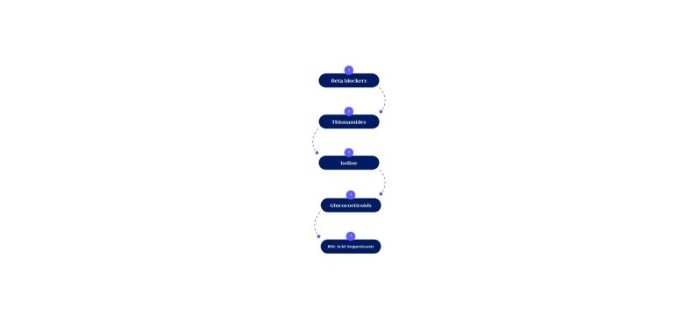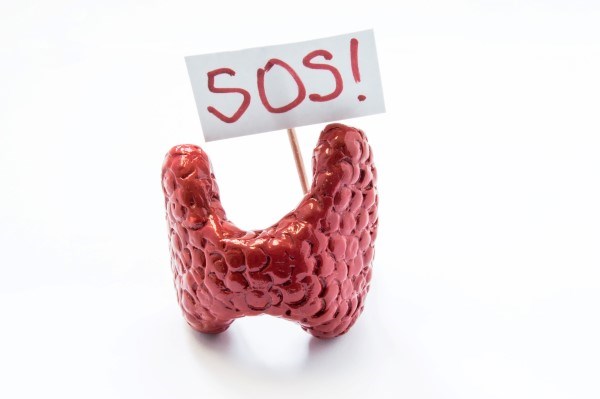Case
A 42-year-old woman, recently diagnosed with Graves’ disease, presents to the emergency department with one day of anxiety, palpitations, and a burning sensation of her skin. She also reports headache, fever at home to 103°F, and watery diarrhea over the past three days. She denies a history of similar episodes or recent illnesses. One month prior, the patient was started on methimazole and atenolol daily; she reports she has been adherent.
Her vitals include: temperature 101.2℉, blood pressure 152/88, heart rate 122, pulse oximetry 100% on room air, and respiratory rate 20. The patient is anxious and diaphoretic with resting bilateral hand tremors and 1+ bilateral lower extremity edema on exam. Workup is notable for thyroid stimulating hormone (TSH) <0.01, T3 233, free T4 1.43, an unremarkable chest X-ray, and sinus tachycardia on ECG.
Making the Clinical Diagnosis
Thyrotoxicosis is a clinical syndrome caused by excess circulating thyroid hormone. Thyroid storm (TS) is the extreme clinical presentation of thyrotoxicosis caused by a hypermetabolic and hyperadrenergic state. It can be difficult to recognize, given its presentation mimics other etiologies of altered mental status. The differential diagnosis includes infection/sepsis, toxidrome (notably stimulant use), structural etiologies (e.g., pheochromocytoma), and metabolic derangements (e.g., hypoglycemia).
TS leads to multi-organ dysfunction:
Neurologic: somnolence, coma, lethargy, convulsions, psychosis, restlessness, delirium, agitation
Gastrointestinal and hepatic: nausea, vomiting, diarrhea, abdominal pain, jaundice, elevated serum bilirubin, transaminitis
Cardiac: palpitations, dyspnea, lower extremity edema and fatigue. Tachycardia is common in TS, with higher ventricular rates, atrial tachyarrhythmias being common (atrial fibrillation, atrial flutter, etc). Additionally, high output heart failure is common with widened pulse pressure.
Thermoregulatory: fever (often in excess of 102℉), diaphoresis with evidence of dehydration
Diagnostics
TS is a clinical diagnosis. Recognition and immediate initiation of treatment are critical to minimize morbidity. Fever and tachycardia are extremely common.
If not considered on the differential diagnosis of altered mental status, this is an easy diagnosis to miss. The Burch and Wartofsky Point Scale is a scoring tool that can aid in the diagnosis of TS. This scale is based on severity of hyperpyrexia, tachycardia, central nervous system involvement, gastrointestinal symptoms, heart failure, presence of atrial fibrillation, and precipitating factors.
Regarding lab findings, low TSH is usually suggestive of TS; however, it is not specific as TSH can be reduced due to chronic hepatic or renal disease, steroid use, and other reasons. High free T3, low TSH, and high/normal free T4 are common findings in patients with TS. Rarely, TSH is elevated due to secondary hyperthyroidism.
Additional diagnostic studies should be performed to evaluate for precipitating causes of TS including infection, acute coronary syndrome (ACS), metabolic disturbances such as diabetic ketoacidosis (DKA), electrolyte disturbances, pregnancy in women of childbearing age, surgery, thromboembolic events, medication changes or nonadherence, and iatrogenic etiologies (such as an iodine load from intravenous [IV] contrast).
Critical Interventions
Patients presenting with TS require emergent intervention. Immediate management includes aggressive fluid resuscitation, although providers need to be mindful of comorbid heart failure. In fulminant volume overload, diuresis may be indicated. Acetaminophen and ice packs may aid in defervescence and cooling. Salicylates should not be given, as they increase free T3 and T4.
In addition to addressing any obvious trigger (infection, metabolic abnormality), the following medical management (Image 1) should be initiated, in order:
Beta-Blockers
Propranolol: blocks adrenergic effects and inhibits T4 to T3 conversion at increased doses. Non-cardiac specific, comes in IV formulation, cautious use in patients with heart failure. Contraindicated in asthma. Dose: 40-80 mg PO every 4 hours, or 1-2 mg IV every 4 hours.
Esmolol: Reduces symptoms due to increased adrenergic tone. Short acting, titratable, better in patients with heart failure. Dose: 500 ug/g/min over 1 minute and then 50-100 ug/kg/min IV.
Thionamides
Propylthiouracil (PTU): inhibits production of T4 and T3 and blocks peripheral T4 to T3 conversion. FDA advisory for liver toxicity. Safer in first trimester of pregnancy. Dose: 500-1000 mg loading dose and then 250 mg every 4 hours. PO, NG, PR.
Methimazole: Blocks new hormone synthesis. Safer than PTU in second and third trimester of pregnancy. Dose: 60-80 mg/day PO, NG.
Iodine
Potassium iodide and Lugol’s solution: Blocks release of hormone from thyroid. Potassium iodine dose: 250 mg every 6 hours PO or NG. Lugol’s solution dose: 4-10 drops every 6-8 hours PO or NG.
Sodium ipodate and iopanoic acid: Blocks release of hormone from thyroid and inhibits T4 to T3 conversion. Sodium ipodate dose: 1-3 g daily PO. Iopanoic acid dose: 1g every 8 hours for 24 hours, then 500 mg every 12 hours PO.
Note: Give at least 1 hour after thionamide therapy is initiated. If given prior to thionamide administration, iodine-containing medications can worsen TS.
Glucocorticoids
Mechanism: Inhibits peripheral conversion of T4 to T3, improves adrenal dysfunction and outcomes.
Dexamethasone dose: 2mg IV, PO, NG every 6 hours.
Hydrocortisone dose: 300 mg load, then 100 mg IV every 8 hours until resolution of symptoms.
Bile Acid Sequestrants
Cholestyramine: reduces reabsorption of metabolized hormone from enterohepatic circulation and facilitates excretion. Dose: 4g orally twice or 4 times daily.

Image 1: Medical Management
Discussion
The clinical manifestations of TS overlap with many illnesses. Therefore, the diagnosis can be challenging to make. However, prompt recognition and evaluation of those presenting with a hypermetabolic state — especially if febrile — is key to diagnosis and initiation of management. It is critical to begin stepwise therapy and evaluate for precipitating factors. Still, no specific precipitant is identified in up to 30% of cases.
TS commonly occurs in patients with Graves’ disease, as in this case. Graves’ disease is caused by thyrotropin receptor antibodies that stimulate uncontrolled thyroid hormone synthesis. It is the most common underlying cause of hyperthyroidism in TS and more frequently affects women.
TS has a high mortality rate (8-30%). Prompt diagnosis and treatment are critical. Multi-organ failure and heart failure are the most common causes of mortality. Prompt treatment and escalation of care to intensive care unit settings can be lifesaving. Most patients with TS will begin to show clinical improvement in 24-48 hours. In rare cases, patients may have refractory disease. In conjunction with endocrinology, patients may be eligible for therapeutic plasma exchange or referral for thyroidectomy. Definitive management is radioactive iodine ablation or surgery.
Take-Home Points
- Clinical features of thyroid storm include cardiovascular symptoms (tachycardia, congestive heart failure), hyperpyrexia, central nervous system disturbance (agitation, psychosis, coma), and gastrointestinal symptoms (vomiting, diarrhea, abdominal pain).
- Treatment should begin with fluid resuscitation, administration of beta blocker followed by initiation of thionamide and glucocorticoids.
- Common triggers for thyroid storm include infection, metabolic disturbances, ischemic pathology, medication changes or nonadherence, ACS, and pregnancy. Up to 30% of patients may have no obvious trigger.
References
Carroll R, Matfin G. Endocrine and metabolic emergencies: thyroid storm. Ther Adv Endocrinol Metab. 2010 Jun;1(3):139-45. doi: 10.1177/2042018810382481. PMID: 23148158; PMCID: PMC3475282.
Chiha M, Samarasinghe S, Kabaker AS. Thyroid storm: an updated review. J Intensive Care Med. 2015 Mar;30(3):131-40. doi: 10.1177/0885066613498053. Epub 2013 Aug 5. PMID: 23920160.
Galindo RJ, Hurtado CR, Pasquel FJ, García Tome R, Peng L, Umpierrez GE. National Trends in Incidence, Mortality, and Clinical Outcomes of Patients Hospitalized for Thyrotoxicosis With and Without Thyroid Storm in the United States, 2004-2013. Thyroid. 2019 Jan;29(1):36-43. doi: 10.1089/thy.2018.0275. Epub 2018 Dec 18. PMID: 30382003; PMCID: PMC6916241.
Idrose AM. Acute and emergency care for thyrotoxicosis and thyroid storm. Acute Med Surg. 2015 May 12;2(3):147-157. doi: 10.1002/ams2.104. PMID: 29123713; PMCID: PMC5667251.
Wolford, R. W. (2019). Thyroid storm. SAEM.org. Retrieved March 12, 2023, from https://www.saem.org/about-saem/academies-interest-groups-affiliates2/cdem/for-students/online-education/m4-curriculum/group-m4-endocrine-electrolytes/thyroid-storm



